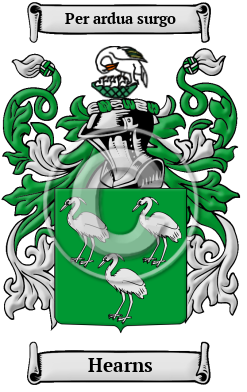| ![Show Contents]() Hearns History, Family Crest & Coats of Arms Hearns History, Family Crest & Coats of Arms
- Origins Available:
Ireland
Etymology of HearnsWhat does the name Hearns mean? Many Irish surnames can be traced back to their Gaelic forms. The name Hearns originally appeared in Gaelic as Ó hEachthigheirn or Ó hEachthigheirna, made up of the words "each" meaning "steed," and "thighearna," meaning "lord." This was first Anglicized O'Hagherin, which was later changed to O'Aherne before the prefix was eventually dropped. 1 Early Origins of the Hearns familyThe surname Hearns was first found in County Clare (Irish: An Clár) located on the west coast of Ireland in the province of Munster, where they held a family seat as a Dalcassian sept from before the year 1000. However, with the disruptions of the Strongbow Invasion of 1172, they migrated southward to counties Cork and Waterford. In Waterford the name is predominantly Hearn and Hearne. Early History of the Hearns familyThis web page shows only a small excerpt of our Hearns research. Another 116 words (8 lines of text) covering the years 1420, 1566, 1754, 1769, 1797 and 1806 are included under the topic Early Hearns History in all our PDF Extended History products and printed products wherever possible. Hearns Spelling VariationsWithin archives, many different spelling variations exist for the surname Hearns. Ancient scribes and church officials recorded names as they were pronounced, often resulting in the name of the single person being recorded under several different spellings. Different spellings that were found include O'Aherne, O'Ahern, Hearne, O'Heffron, Haveran, Hayveren and many more. Early Notables of the Hearns familyMore information is included under the topic Early Hearns Notables in all our PDF Extended History products and printed products wherever possible. Hearns Rankingthe United States, the name Hearns is the 10,068th most popular surname with an estimated 2,487 people with that name. 2
| Hearns migration to Canada | + |
Irish families fled the English-colonized Ireland in record numbers during the 19th century for North America. Many of those destitute families died from disease during, and even shortly after, the long journey. Although those that immigrated before the Great Potato Famine of the 1840s often were granted a tract of land, those that arrived later were generally accommodated in urban centers or in work camps. Those in the urban centers would labor in the manufacturing sector, whereas those in work camps would to build critical infrastructures such as bridges, canals, roads, and railways. Regardless of when these Irish immigrants came to North America, they were critical for the rapid development of the young nations of the United States and Canada. Early immigration and passenger lists have recorded many early immigrants bearing the name of Hearns: Hearns Settlers in Canada in the 18th Century- Mr. Gilbert Hearns U.E. who settled in Canada c. 1784 3
| Hearns migration to Australia | + |
Hearns Settlers in Australia in the 19th Century- Judith Hearns, aged 25, a servant, who arrived in South Australia in 1855 aboard the ship "Europa" 4
| Contemporary Notables of the name Hearns (post 1700) | + |
- Ronald Hearns (b. 1978), American professional boxer and the son of Thomas "Hitman" Hearns
- Thomas "Hit Man" Hearns (b. 1958), American boxer, first boxer to win world titles in four divisions, best known for his fights with Sugar Ray Leonard, Marvin Hagler and Roberto Durán
The motto was originally a war cry or slogan. Mottoes first began to be shown with arms in the 14th and 15th centuries, but were not in general use until the 17th century. Thus the oldest coats of arms generally do not include a motto. Mottoes seldom form part of the grant of arms: Under most heraldic authorities, a motto is an optional component of the coat of arms, and can be added to or changed at will; many families have chosen not to display a motto.
Motto: Per ardua surgo
Motto Translation: I rise through difficulties.
- MacLysaght, Edward, Irish Families Their Names, Arms and Origins 4th Edition. Dublin: Irish Academic, 1982. Print. (ISBN 0-7165-2364-7)
- "What are the 5,000 Most Common Last Names in the U.S.?". NameCensus.com, https://namecensus.com/last-names/
- Rubincam, Milton. The Old United Empire Loyalists List. Genealogical Publishing Co., Inc, 1976. (Originally published as; United Empire Loyalists. The Centennial of the Settlement of Upper Canada. Rose Publishing Company, 1885.) ISBN 0-8063-0331-X
- South Australian Register Monday 14th May 1855. (Retrieved 2010, November 5) Europa 1855. Retrieved http://www.theshipslist.com/ships/australia/europa1855.shtml
 |

